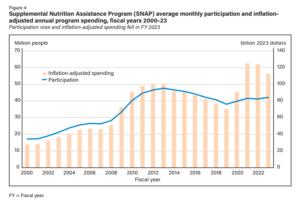The Trump administration is launching a $700 million initiative, potentially supplemented with corporate funding, to help farmers adopt regenerative agriculture practices. The pilot program will use $400 million from the…
SNAP Participation Up, Spending Down in 2023
Participation in the Supplemental Nutrition Assistance Program (SNAP) increased 2.3% in 2023 to an average of 42.1 million people each month, while total federal spending on the program decreased 5.6% in 2023 to $112.8 billion, according to new research from the USDA’s Economic Research Service.
The 42.1 million people participating in SNAP each month “was the highest participation level since 2017,” according to the Economic Research Service’s Jordan W. Jones and Saied Toossi and means that “about 12.6 percent of the U.S. resident population participated in SNAP in an average month, up from 12.4 percent in FY 2022.”
In addition to decreased overall spending, which Jones and Toossi said was largely “driven by the expiration of emergency allotments,” there was a significant 8% decrease in SNAP benefits per person to $211.93 per month in 2023. “Of the total $112.8 billion in Federal SNAP spending, $90.2 billion funded regular SNAP benefits and $16.6 billion funded disaster supplements to ongoing SNAP recipients, almost all of which were emergency allotments,” Jones and Toossi wrote in a report released Wednesday.

Jones and Toossi reported that the increase in SNAP participation in 2023 occurred despite the end of a number of programs that expanded eligibility, largely in response to the coronavirus pandemic.
“The end of the Public Health Emergency in May 2023 led to the sunsetting of additional exemptions that expanded eligibility among higher education students and waivers allowing certain administrative flexibilities,” Jones and Toossi reported. “There were also substantial changes to the work requirements on ‘able-bodied adults without dependents’ (ABAWDs) following the Public Health Emergency expiration and the Fiscal Responsibility Act of 2023.”
WIC Participation and Spending Increased in 2023
Participation in the Special Supplemental Nutrition Program for Women, Infants, and Children (WIC) increased to 6.6 million people per month in fiscal year 2023, which is 5% higher than in FY 2022. In addition, federal spending on the WIC program in 2023 was $6.6 billion, an increase of 14.9% from 2022.
“The number of women participating in WIC increased by 6.1 percent, the second consecutive year of increasing participation among women. FY 2023 also marked the first increase in participation among infants since 2009 and the third consecutive fiscal year that participation increased among children,” Jones and Toossi reported. “The number of infants participating in WIC increased by 2.9 percent from the previous fiscal year while the number of children increased by 5.5 percent.”
“Food costs per person averaged $55.95 per month, an increase of $8.21 (17.2 percent) from the previous fiscal year,” Jones and Toossi reported. “After adjusting for inflation, average per person food costs were at their highest level since FY 2013.”
Total Food and Nutrition Federal Spending in 2023

Jones and Toossi reported that “federal spending for USDA’s domestic food and nutrition assistance programs totaled $166.4 billion in FY 2023. Federal spending in FY 2023 was 9.7 percent lower than the nominal spending of $184.2 billion in FY 2022. Adjusted for inflation, spending was down 13.0 percent from a total of $191.1 billion in FY 2022 … and down 17.8 percent from a peak of $202.4 billion in FY 2021.”
“Adjusted for inflation, FY 2023 spending was 54.5 percent higher than in FY 2019, the last full fiscal year before the pandemic, and 21.2 percent higher than in FY 2013, the prepandemic high,” Jones and Toossi reported.





